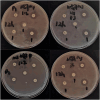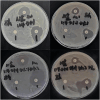Is aromatic plants environmental health engineering (APEHE) a leverage point of the earth system?
- PMID: 38756557
- PMCID: PMC11096952
- DOI: 10.1016/j.heliyon.2024.e30322
Is aromatic plants environmental health engineering (APEHE) a leverage point of the earth system?
Abstract
It is important to note that every ecological niche in an ecosystem is significant. This study aims to assess the importance of medicinal and aromatic plants (MAPs) in the ecosystem from multiple perspectives. A primary model of Aromatic Plants Environmental Health Engineering (APEHE) has been designed and constructed. The APEHE system was used to collect aerosol compounds, and it was experimentally verified that these compounds have the potential to impact human health by binding to AKT1 as the primary target, and MMP9 and TLR4 as secondary targets. These compounds may indirectly affect human immunity by reversing drug resistance in drug-resistant bacteria in the nasal cavity. This is mainly achieved through combined mutations in sdhA, scrA, and PEP. Our findings are based on Network pharmacology and molecular binding, drug-resistance rescue experiments, as well as combined transcriptomics and metabolomics experiments. It is suggested that APEHE may have direct or indirect effects on human health. We demonstrate APEHE's numerous potential benefits, such as attenuation and elimination of airborne microorganisms in the environment, enhancing carbon and nitrogen storage in terrestrial ecosystems, promoting the formation of low-level clouds and strengthening the virtuous cycle of Earth's ecosystems. APEHE also supports the development of transdisciplinary technologies, including terpene energy production. It facilitates the creation of a sustainable circular economy and provides additional economic advantages through urban optimisation, as well as fresh insights into areas such as the habitability of other planets. APEHE has the potential to serve as a leverage point for the Earth system. We have created a new research direction.
© 2024 The Author(s).
Conflict of interest statement
The authors declare the following financial interests/personal relationships which may be considered as potential competing interests:MengYu Lu has patent #CN111937664B licensed to HEFEI XIAODOUKOU HEALTH TECH CO LTD. If there are other authors, they declare that they have no known competing financial interests or personal relationships that could have appeared to influence the work reported in this paper.
Figures






















Similar articles
-
The Minderoo-Monaco Commission on Plastics and Human Health.Ann Glob Health. 2023 Mar 21;89(1):23. doi: 10.5334/aogh.4056. eCollection 2023. Ann Glob Health. 2023. PMID: 36969097 Free PMC article. Review.
-
Planning Implications Related to Sterilization-Sensitive Science Investigations Associated with Mars Sample Return (MSR).Astrobiology. 2022 Jun;22(S1):S112-S164. doi: 10.1089/AST.2021.0113. Epub 2022 May 19. Astrobiology. 2022. PMID: 34904892
-
Beyond the principle of plentitude: a review of terrestrial planet habitability.Astrobiology. 2005 Apr;5(2):100-26. doi: 10.1089/ast.2005.5.100. Astrobiology. 2005. PMID: 15815163 Review.
-
The astysphere and urban geochemistry-a new approach to integrate urban systems into the geoscientific concept of spheres and a challenging concept of modern geochemistry supporting the sustainable development of planet earth.Environ Sci Pollut Res Int. 2009 Jul;16(5):539-45. doi: 10.1007/s11356-009-0183-8. Epub 2009 Jun 9. Environ Sci Pollut Res Int. 2009. PMID: 19506928
-
The Role of N2 as a Geo-Biosignature for the Detection and Characterization of Earth-like Habitats.Astrobiology. 2019 Jul;19(7):927-950. doi: 10.1089/ast.2018.1914. Astrobiology. 2019. PMID: 31314591
Cited by
-
Electrospun Nanofibers from Plant Natural Products: A New Approach Toward Efficient Wound Healing.Int J Nanomedicine. 2024 Dec 27;19:13973-13990. doi: 10.2147/IJN.S501970. eCollection 2024. Int J Nanomedicine. 2024. PMID: 39742091 Free PMC article. Review.
References
-
- Berini J.L., Brockman S.A., Hegeman A.D., Reich P.B., Muthukrishnan R., Montgomery R.A., Forester J.D. Combinations of abiotic factors differentially alter production of plant secondary metabolites in five woody plant species in the boreal-temperate transition zone. Front. Plant Sci. 2018;9:1257. doi: 10.3389/fpls.2018.01257. - DOI - PMC - PubMed
-
- Srivastava Shikha, Srivastava Saurabh, Singh Manju Rawat, Singh Deependra, Tekwani Babu L. In: Advances and Avenues in the Development of Novel Carriers for Bioactives and Biological Agents. Singh Manju Rawat, Singh Deependra, Kanwar Jagat R., Chauhan Nagendra Singh., editors. Academic Press; 2020. Chapter 11 - novel perspectives for delivery of bioactives through blood–brain barrier and treatment of brain diseases; pp. 317–341. ISBN 9780128196663. - DOI
-
- Menizibeya O. Welcome,Blood brain barrier inflammation and potential therapeutic role of phytochemicals. PharmaNutrition. 2020;11 doi: 10.1016/j.phanu.2020.100177. ISSN 2213-4344. - DOI
-
- Ahmed Walaa M.S., Abdel-Azeem Naglaa M., Ibrahim Marwa A., Helmy Nermeen A., Radi Abeer M. Neuromodulatory effect of cinnamon oil on behavioural disturbance, CYP1A1, iNOStranscripts and neurochemical alterations induced by deltamethrin in rat brain. Ecotoxicol. Environ. Saf. 2021;209 doi: 10.1016/j.ecoenv.2020.111820. ISSN 0147-6513. - DOI - PubMed
LinkOut - more resources
Full Text Sources
Miscellaneous

